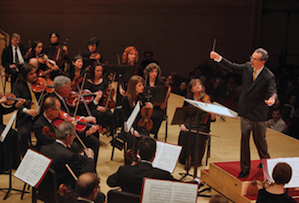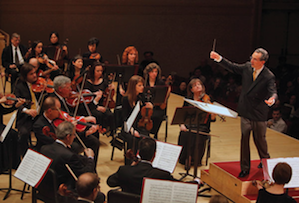
Photo by Cory Weaver
In the week since the Metropolitan Opera's announcement of canceling planned HD casts of John Adams' The Death of Klinghoffer, the intense controversy has peaked instead of subsiding. Social media and such lists as Opera-L deal with nothing else, against a few words of praise for the Met's action, there is an international outburst of denounciations.
Music critics and editorials at the Los Angeles Times, New York Times, and elsewhere have decried the cancelation. In the San Francisco Chronicle, Joshua Kosman said Metropolitan Opera general manager Peter Gelb "laid down a new marker for institutional cowardice" when he gave in to the demands to cancel the planned live HD broadcast in November.
Adams expressed regret over the decision:
My opera accords great dignity to the memory of Leon and Marilyn Klinghoffer, and it roundly condemns his brutal murder. It acknowledges the dreams and the grievances of not only the Israeli but also the Palestinian people, and in no form condones or promotes violence, terrorism or anti-Semitism. [Cancelation of the simulcast] is a deeply regrettable decision and goes far beyond issues of "artistic freedom," and ends in promoting the same kind of intolerance that the opera’s detractors claim to be preventing.
There is not much to add beyond repetitions of the arguments, so it's a kind of relief to have Thomas Zand call attention to the fate of the ship that was the setting for the opera and its real-life story.

The MS Achille Lauro was a cruise ship based in Naples, Italy. Built between 1939 and 1947 as MS Willem Ruys, a passenger liner for the Rotterdamsche Lloyd, it was hijacked by members of the Palestine Liberation Front in 1985. In 1994, the ship caught fire and sank in the Indian Ocean off Somalia.
The Met, of course, is also in the headlines because of the contract negotiations with the Musicians Union, recrimination and threats flying all around. On Monday, the New York Times weighed in editorially:
Both sides are threatening to shut the Met just as rehearsals for a new season start. Instead, both sides should compromise on real cuts. For the unions, this means accepting changes in benefits and work rules. Management will have to cut salaries and expenses just as rigorously.The Met cannot continue on its present course. The opera’s annual budget was $327 million last year, about $200 million of which goes for payments and benefits to union employees. Those employees, who often work long hours, include some of the most talented people in their professions. Their pay reflects that expertise, with average earnings for the chorus and orchestra running about $200,000 a year. Mr. Gelb estimates that full-time chorus members earn $200,000 in salary and $100,000 in benefits, including nine weeks off with full pay. For the average full-time orchestra member, it’s $200,000 in pay and $85,000 in benefits, including 16 weeks off with pay.
Orchestra musicians of the Met, represented by Local 802, American Federation of Musicians, responded that they too are deeply concerned about the future of the company, but took issue with the Times editorial, contradicting Gelb's claim of 16 weeks' vacation and average salary. Musicians say their guaranteed time off is "equivalent to that of their peer orchestras (10 weeks), and is in part due to the recognition that they are at the disposal of the Met to perform six days a week during the season." On salaries, the union claim is that Gelb's figures have not been substantiated. The statement continues:
Given that last year the Met reported a $2.8 million dollar deficit, why does Gelb claim he needs $30 million in cuts (16%) to performers who are already being paid less than musicians in several other U.S. orchestras, in some cases in absolute dollars or, when calculating the cost-of-living to compensation ratio, less than their counterparts at most peer orchestras?Also, importantly, research conducted by the orchestra indicates that the various cuts that Gelb has proposed actually constitute a reduction in compensation much greater than 16%, but in fact would constitute a 25-37% reduction in compensation.

